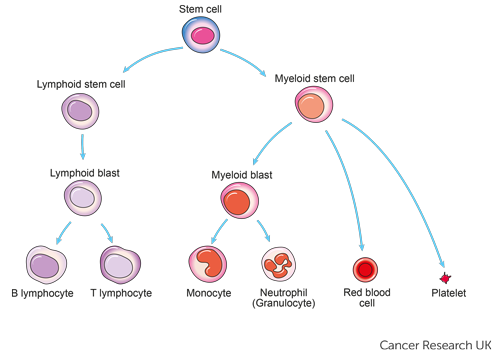Adult Acute Lymphoblastic Leukemia (ALL) is a type of cancer found in blood and bone marrow. Also called Acute Lymphocytic Leukemia, ALL usually gets worse quickly if it is not treated.
Tap “Watch Now” for an easy-to-understand overview of Adult Acute Lymphoblastic Leukemia.
- Adult Acute Lymphoblastic Leukemia
Overview
Adult Acute Lymphoblastic Leukemia, also referred to as ALL, is a type of cancer in which your bone marrow makes too many lymphocytes shown here on the left bottom in purple. Lymphocytes are a type of white blood cell.
Normally, your bone marrow makes blood stem cells, also known as immature cells, that in time become mature blood cells. If you have ALL, too many stem cells become abnormal lymphoblasts, B lymphocytes, or T lymphocytes which are different types of leukemia cells. In addition, as the number of leukemia cells increase in your blood and bone marrow, there is less room for healthy white blood cells, red blood cells, and platelets to exist.
What Tests Will I Need and Why?
Blood and Imaging tests are done to understand your general health and confirm your diagnosis.
Tissue analysis is also typically done to identify certain biomarkers, including Philadelphia Chromosome (Ph), which is critical to finding the best treatment option for you. Ph+ is found in 25% of adults with ALL.
You will also require Bone Marrow Analysis and a sample of Spine Liquid to obtain more information about your diagnosis.
If your treatment team has not already performed tests to determine your cancer’s features, please ask your doctor when these tests will be performed.
Re-read this summary as needed and then tap, “Compare My Treatment Options Now“. Our unique Comparison Page will help you understand your FDA-approved treatment options including, who can help you pay for your treatment, where and how each is given and what side-effects you may experience.

National Institute of Health/ treatment-leukemia
Recommended Leukemia Cancer Videos

What Is Blood Cancer
Brought To You By Black Health Matters

Leukemia Causes, Signs and Symptoms
What is Leukemia?

How Cancer Spreads
Metastastis

Diagnosing Your Cancer
How Does a CT Scan Work?

Diagnosing Your Cancer
How Does a PET Scan Work?

Exercise! You Can Do It
Reducing Side Effects & More
Commonly Searched Questions
Acute Lymphoblastic Leukemia (ALL) Definition
Acute Lymphocytic Leukemia (ALL) is also called Acute Lymphoblastic Leukemia. “Acute” means that the Leukemia can progress quickly, and if not treated, would probably be fatal within a few months. “Lymphocytic” means it develops from early (immature) forms of lymphocytes, a type of white blood cell.
Source: www.cancer.org
Acute Lymphoblastic Leukemia (ALL) Survival Rate
The average five-year survival in Acute Lymphocytic Leukemia (ALL) is 70.8%.
According to SEER data, Acute Lymphoblastic Leukemia has a survival rate of 70.8%. For example, if the 5-year relative survival rate for a specific stage of acute lymphocytic leukemia is 70.8%, it means that patients who have that cancer are, on average, about 70.8% as likely as patients who don’t have that cancer to live for at least 5 years after being diagnosed.
Source: Cancer.gov
Acute Lymphoblastic Leukemia (ALL) Symptoms
The early signs and symptoms of ALL may be like the flu or other common diseases. These includes:
- Weakness or feeling tired.
- Fever or drenching night sweats.
- Easy bruising or bleeding.
- Petechiae (flat, pinpoint spots under the skin, caused by bleeding).
- Shortness of breath.
- Weight loss or loss of appetite.
Source: Cancer.gov
Acute Lymphoblastic Leukemia (ALL) Treatment
There are four types of standard treatment are used:
- Chemotherapy
- Radiation therapy
- Chemotherapy with stem cell transplant
- Targeted therapy
Source: www.cancer.gov
Acute Lymphoblastic Leukemia (ALL) Recurrence Rate
The recurrence rate for Acute Lymphoblastic Leukemia (ALL) can vary based on several factors including the patient’s age, the specific characteristics of the leukemia, and the treatments used.
Overall Recurrence Rates:
- Children: The overall survival rate for children with ALL is relatively high, but relapse can occur in about 15-20% of cases.
- Adults: The recurrence rate in adults tends to be higher compared to children, with about 40-50% of adults experiencing relapse.
Recurrence rates can be influenced by the response to initial treatment and whether the leukemia has specific genetic abnormalities. For more precise information related to individual cases, consulting with a healthcare professional is recommended.
Source: www.cancer.gov
Acute Lymphoblastic Leukemia (ALL) Prevention
There are no specific prevention strategies for Acute Lymphoblastic Leukemia (ALL) because its exact causes are not well understood and are likely influenced by a combination of genetic and environmental factors. However, general approaches to potentially lower the risk of leukemia include:
- Avoid Exposure to Radiation: Limit unnecessary exposure to high levels of radiation, such as through medical imaging or environmental sources.
- Limit Exposure to Chemicals: Reduce exposure to known carcinogens, such as certain industrial chemicals and solvents.
- Healthy Lifestyle: Maintain a balanced diet, engage in regular physical activity, and avoid smoking, as overall health can influence cancer risk.
- Genetic Counseling: For individuals with a family history of leukemia or genetic conditions associated with higher cancer risk, consider genetic counseling and screening.
-
These measures focus on reducing general cancer risk, as specific preventive strategies for ALL are not established. For personalized guidance, consulting with a healthcare provider is recommended.
Source: www.cancer.gov






